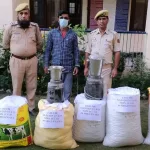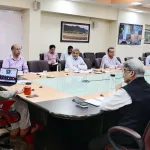The Pandras area of Drass holds a significant place in the region, particularly for its unique role in heralding the arrival of winter through the commencement of the grass harvest. Drass itself is a small town located in the Kargil District of the Union Territory of Ladakh, Known as the “Gateway to Ladakh,” Drass is renowned for its extreme cold temperatures during the winter months, often considered as one of the coldest inhabited places on Earth.
Pandrass area is famous for producing the best fodder for animals “Khaseel”.The harvesting of the Khaseel starts from August and its sowing period is March to April. As per locals, the harvesting of this fodder symbolizes the beginning of Autumn. Locals store this fodder for winter and also supply it to other areas.
The phenomenon of grass harvest in the Pandras area of Drass marks a critical transition in the local environment and the lives of the people residing there. As the warmer months come to an end, and the cool whispers of autumn begin to take over, the grasses of Pandras start to show signs of maturation. This marks the beginning of the grass harvest, a practice that is closely intertwined with the unique climate and traditional lifestyle of the region.
The grass harvest in Pandras has profound implications for the local population. The harvested grass is not just a resource; it is a vital lifeline for the villagers and their livestock during the harsh winter months. The grass is used as fodder for the livestock, which is the primary source of sustenance for many families in this remote region. The careful collection and storage of grass represent a meticulous process that embodies the spirit of community cooperation and the preservation of resources.
Moreover, the commencement of grass harvest in Pandras acts as a harbinger of the impending winter. The onset of winter in Drass is a remarkable natural event, with temperatures plummeting to staggering lows and snow covering the landscape in a thick blanket. This seasonal change affects every aspect of life in the region, from transportation and agriculture to the daily routines of the local inhabitants. The start of the grass harvest serves as a timely reminder that the residents of Pandrass need to brace themselves for the challenges that winter brings.
The connection between the grass harvest and the arrival of Autumn extends beyond the practical aspects. It is a cultural and traditional link that has been passed down through generations. The people of Pandrass have developed an intimate understanding of their environment, relying on their ancestral knowledge to navigate the harsh conditions of the region. The grass harvest not only provides them with a means of survival but also reinforces their connection to the land and their heritage.
In recent years, however, the traditional rhythms of life in Pandras have faced several challenges. Climate change, with its unpredictable patterns and shifting weather conditions, has posed threats to the delicate balance that the villagers have maintained with their environment for centuries. Rapid modernization and changing economic dynamics have also led to shifts in traditional practices, impacting the significance of the grass harvest and its role in predicting the onset of winter.
The Pandrass area of Drass holds a unique and profound significance as the place where the grass harvest marks the beginning of the arrival of Autumn Season. This practice is deeply ingrained in the cultural, environmental, and economic fabric of the region. It is a symbol of the symbiotic relationship between the people of Pandrass and their environment, a relationship that has sustained them through the harshest of conditions.
As we look to the future, it is imperative to recognize and preserve the traditions and practices that define places like Pandrass, ensuring that their cultural heritage and adaptive wisdom continue to thrive in a rapidly changing world.





